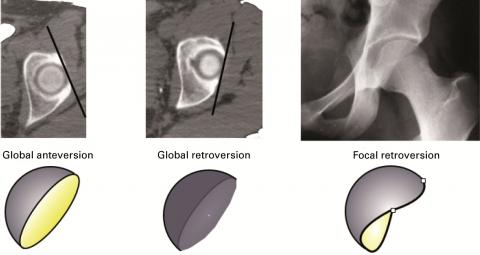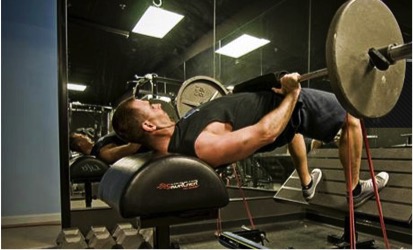Beyond the Butt Wink: Part 3
So in my attempt to break the internet, the previous two components of this series looked at the specific research behind the variations in hip structure and the relative risk of injuries associated with some of those alignments (Part 1 HERE) and also methods you could use to assess yourself to determine not only the possible shape of your hip, but also the workable range of motion you could have for movements like the squat (Part 2 HERE). Today’s section is going to look at specific methods you can use to work within the limits and possibilities of specific hip geometries and also how to position for different exercises to optimize performance while also reducing injuries.
Essentially, it’s going to be awesome.
For the most part, there’s a couple of key configurations to consider. First, the acetabulum could be oriented in either an anteverted position or retroverted position. If neither of those terms means anything to you, please click the two links above and review so I can keep the flow going here.
The orientation of the acetabulum could also be more inferior or lateral, as determined from the hip scouring test featured on part 2. If the path of motion is flexed to 90 and then doesn’t allow further flexion past 90 degrees, the acetabular positioning is more inferior and potentially retroverted. If the hip can flex further with mild abduction, the positioning is more lateral and possibly somewhat anteverted. If the hip allows flexion when abducted, but then squares off again higher up, the hip could have more of an elliptical shape, or what’s known as focal retroversion.
Fern & Norton showed variations like these:
Second, yet equally as important is whether the femoral neck is thick or whether the hip acetabulum is extra deep. In many instances, this can’t be determined with individual assessments, but is more reflective of the overall motion of the hip. If someone has a very high degree of mobility, the likelihood of their having a thin femoral neck and a shallow socket is pretty high. If they have all the mobility of a clam, they likely have a deeper socket and thicker femoral neck. This combination, regardless of orientation of the acetabulum, will limit the overall diameter of the conical range of motion of the hip due to earlier contact with the acetabulum compared to a thinner neck and shallower socket.
So let’s break down the different configurations and how they’ll impact movement.
1. Anteverted Socket, lateral positioning, thin neck with shallow socket
These folks are built to squat. They can hit full depth without a problem and have little to no risk of developing impingement or developing low back flexion at the bottom of the movement. They may have good hip extension or just get to neutral. They could also be considered close to hypermobile with how freaky their overall ease with hip movement appears.
In most instances, foot placement won’t have to be too specific. Most freedom of movement will come with slight external rotation of the feet and slight external drive from the knees with both squats and deadlifts. These are the people everyone says you should be able to emulate when they talk about “optimal mechanics” for compound lifts.
2. Anteverted Socket, inferior positioning, thin neck with shallow socket
These folks can squat, but need a slightly wider stance with feet turned out to slightly to make it happen. If they squat with their feet together, they’ll get some impingement and hit a point of restriction to the movement, but moving their feet slightly apart and turning the toes out slightly means they can drop into it like a key just unlocked the door. Flexion is great with slight abduction and external rotation, and extension is usually slightly past neutral.
Most of the beneficial positions for these people will be slightly wider than neutral, mild external rotation, and being cognizant of where they begin to tuck their hips under with a butt wink. Usually it will be below 90 degrees, but not right to the floor unless they’re very wide. For that position though, if they do all their work that wide they will likely develop some hip irritation from the lateral musculature getting jammed up. That’s a technical term, so use it carefully. Extension work will be best with feet slightly wider than shoulder width apart, and potentially with some slight external rotation of the feet. The total range of motion will usually be past neutral, but only by about 10-20 degrees.
3. Anteverted socket, thicker neck or deeper socket
They can still go through flexion, but not as much as the others. Extension is still maintained for the most part. As mentioned above, the thick neck/deep socket just reduces the size of the cone of motion. The relative centre of that cone is still the same.
These guys and gals will struggle with mobility, but find squatting easier than extension work. They will usually develop a butt wink or anterior hip pain with routine squatting, which means they would be wise to limit the range of motion through flexion movements to just 90 degrees, regardless of foot positioning. For this, box squats would be fantastic to use as the majority of training volume, with deep squats only reserved for those who need to hit depth for powerlifting meets in the lead-up to their competitions.
For extension work, there should be no problem with most activities that require flexion of the hips to 90 degrees as the set up. This would include conventional deadlifts pulled from the floor, and would be best mixed with varied stances such as conventional and sumo during these movements. For most individuals, rack or block pulls wouldn’t be necessary if they could maintain a neutral lumbar position at the bottom of their movement from the floor. If not, they would be best to pull from small blocks or from the rack.
Additionally, terminal range hip extension movements like barbell hip thrusts will be difficult to get full range of motion past 90 degrees, regardless of the load used.
4. Retroverted socket, lateral placement, thin neck & shallow socket
Flexion is troublesome and limited. Most of the movement will stop roughly around 90 degrees, but can get slightly deeper with more abduction. Wider stances work best with these hips when involving flexion, but there’s still risk of impingement or lumbar flexion if you go too deep. Extension is usually awesome, and range is quite often past neutral.
Because of the limited flexion and lateral placement of the acetabulum, stances would have to be wider than shoulder width, but flexion would still not be past 90 degrees in most individuals. Likewise these individuals would be wise to limit the flexion requirement for their movements. Squat depth would be limited to the point where lumbar flexion occurred and where no additional hip flexion occurred. Box squats or pin squats would be fantastic.
For extension movements, hip flexion at the starting position will likely not be able to exceed 90 degrees, which means pulling a bar from the floor in a conventional stance won’t work. Most floor pulls will require sumo stance, if at all. The good thing is that terminal range hip extension movements like hip thrusts will be completely OWNED by these individuals, often letting them get to 10-20 degrees past neutral without much issue, and zero anterior hip pain.
5. Retroverted socket, inferior placement, thin neck & shallow socket
These guys just can’t get any flexion to save their life. They’re lucky to get to 90 degrees, whether their feet are wide or narrow, toes out or forward. They can do all the mobility in the world, but it won’t improve their squat depth to save their life. They would be better suited to work on preventing anterior pelvic tilt from occurring while also hammering posterior chain work like no ones business.
As with the lateral placement, retroverted and inferior placement folks have stupid awesome extension range, and these guys are usually the ones who have the most. The hip flexion limit is still there and likely more so than in the lateral placement, so doing hip extension work with more than 90 degrees flexion will be next to impossible without lumbar flexion. Block pulls or rack pulls will absolutely be necessary, but they will have a very powerful lockout. Similarly, hip thrusts will be their best friend.
6. Retroverted Socket, thick neck & deep socket
These guys and gals epitomize the cone on the right in the diagram shown earlier. Their overall range of motion is very restricted, but as discussed in the previous instalment of this series, they’re the ones who are good for storming, not for squatting. They’ll never have to worry about hip pain while walking long distances, and can carry weight like no ones business.
They can usually get to 90 degrees flexion, regardless of how wide the hip is abducted, and then their hip extension is likely going to be neutral, if at all past that. Again, where there’s a limitation, there’s an opportunity. While big ranges of motion may be out of the question, they can carry weight like no ones’ business. They can also excel at single leg work, lunges, and anything that involves moving through a range of motion from neutral to 90 degrees flexion.
A downside to these hip settings is that when forcing motion beyond the available range, the lumbar spine will almost inevitably take over. These are the folks that have massive lumbar hinges when it comes to forward flexion.
With any hip alignment, there is still considerable work that can be done with lunges, single leg work, hinge patterns and squats, as long as their own limitations are considered. In many cases, the safest observable coaching cue to look for would be whether the low back flexes during hip flexion movements, and finding the stance width and toe angle that allows the most free movement into a flexed position without anterior hip pain or low back rounding.
Extension based work presents very little risk, regardless of the hip alignment, as long as the flexion position doesn’t involve using lumbar flexion to get there. If so, limit the depth of flexion to preserve the hips and spine while still allowing movement to occur from the hips. End range extension will be achievable for most alignments up to 90 degrees, with some able to get significantly past this mark.
In the end, just remember the simple concept that everyone is different. There is no one optimal position or posture for everyone, but everyone can do any exercise they like. They would just be wise to adjust the exercise to meet their unique needs versus trying to force a posture or position that may not be possible. Improvements in range of motion can be made in any alignment, but will be limited by structure, which means don’t stop, but work within reason. I know it’s not as catchy as the Journey song, but it works better.






5 Responses to Beyond the Butt Wink: Part 3